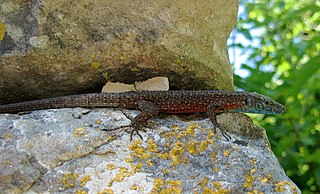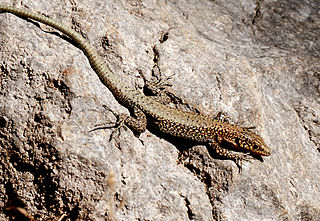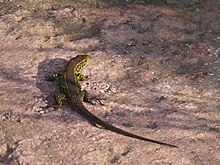
The Lacertidae are the family of the wall lizards, true lizards, or sometimes simply lacertas, which are native to Afro-Eurasia. It is a diverse family with at about 360 species in 39 genera. They represent the dominant group of reptiles found in Europe. The group includes the genus Lacerta, which contains some of the most commonly seen lizard species in Europe.

Algyroides is a genus of lizards of the family Lacertidae.

Lacerta is a genus of lizards of the family Lacertidae.

Takydromus is a genus of lizards, commonly called grass lizards or oriental racers. Species of the genus Takydromus are endemic to a large part of Asia. Members of this genus are noticeable because of their slender appearance and their agile movements. The word takydromus derives from Greek ταχυδρόμος (takhudromos), "fast-running", from ταχύς (takhus), "swift" + δρόμος (dromos), "course, race".

Ablepharus kitaibelii, commonly known as the European copper skink, European snake-eyed skink, juniper skink, or snake-eyed skink, is a species of skink, a lizard in the family Scincidae. The species is endemic to Eastern Europe and Southwestern Asia.

Fitzinger's algyroides, also commonly called the pygmy algyroides and the pygmy keeled lizard, is a species of lizard in the family Lacertidae. The species is native to the islands of Corsica and Sardinia in the Mediterranean. There are no subspecies.

The Spanish algyroides, also commonly known as the Spanish keeled lizard or Valverde's lizard, is a species of lizard in the family Lacertidae.

The blue-throated keeled lizard, or Dalmatian algyroides, is a species of lizard in the family Lacertidae.

Aurelio's rock lizard is a species of lizard in the family Lacertidae. The species is endemic to the Iberian peninsula.
Phoenicolacerta kulzeri is a species of lizard in the family Lacertidae. The species is endemic to Western Asia.

The Peloponnese wall lizard is a species of lizard in the family Lacertidae. It is endemic to the Peloponnese region of southern Greece. Its natural habitats are Mediterranean-type shrubby vegetation, rocky areas, arable land, pastureland, plantations, and rural gardens.
Iranolacerta zagrosica, also known commonly as the Zagros Mountains lacerta, is a species of lizard in the family Lacertidae. The species is endemic to Iran.

Phoenicolacerta is a genus of wall lizards of the family Lacertidae. The genus was described in 2007.
Iranolacerta is a genus of wall lizards of the family Lacertidae.
Iranolacerta brandtii, also known commonly as Brandt's Persian lizard, is a species of lizard in the family Lacertidae. The species is native to eastern Europe and western Asia. There are two recognized subspecies.

Danford's lizard is a species of lizard in the family Lacertidae. The species is native to Greece and Turkey. There are no subspecies that are recognized as being valid.
Darevskia steineri, also known commonly as Steiner's lizard, is a species of lizard in the family Lacertidae. The species is endemic to Iran.

Darevskia valentini, also known commonly as the Caucasian rock lizard or Valentin's lizard, is a species of lizard in the family Lacertidae. The species is native to southeastern Europe and western Asia. There are three recognized subspecies.
Edwin Nicholas "Nick" Arnold, is a British herpetologist and former Curator of Herpetology at the Natural History Museum, London. Arnold made seminal contributions to the herpetology of Europe and North Africa, especially on geckos and lizards of the family Lacertidae. He discovered and described 36 species and 4 subspecies of reptiles, and wrote A Field Guide to the Reptiles and Amphibians of Britain and Europe, which appeared over multiple editions.














